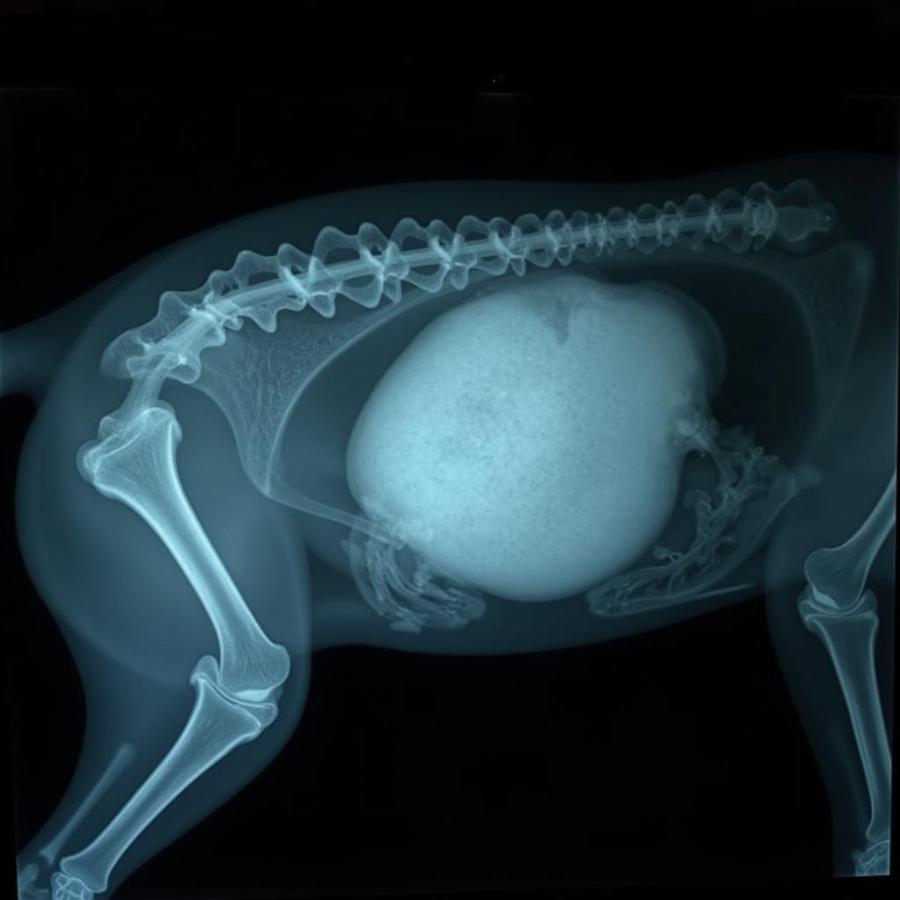Pyometra in dogs is a severe and potentially life-threatening uterine infection. Searching for “pictures of pyometra in dogs” likely indicates concern about a pet’s health and a desire to understand this condition visually. This article will provide valuable information about pyometra, including its causes, symptoms, diagnosis, and treatment options, alongside visual aids to help you better understand this critical condition.
Recognizing Pyometra: Symptoms and Visual Clues
Pyometra occurs when the uterus fills with pus, creating a toxic environment. It’s most common in unspayed female dogs, especially those over six years old. Early recognition is vital, so understanding the symptoms is crucial. While pictures can be helpful, they shouldn’t replace a veterinary diagnosis. Common signs include increased thirst and urination, lethargy, loss of appetite, vomiting, and a distended abdomen. Vaginal discharge can also occur, ranging from watery and bloody to thick and pus-filled.
Some dogs may exhibit only subtle signs, making early diagnosis challenging. This is why regular veterinary checkups are so important, especially for senior, unspayed females.
Types of Pyometra and Diagnostic Approaches
There are two main types of pyometra: open and closed. In open pyometra, the cervix remains open, allowing pus to drain from the vagina. vaginal discharge in dogs In closed pyometra, the cervix is sealed, trapping the pus inside the uterus, leading to a rapid and dangerous buildup of toxins. This type can be particularly difficult to detect without a veterinary examination. Diagnosis typically involves a combination of physical examination, blood tests, and imaging studies, such as X-rays or ultrasound.
 Hình ảnh X quang chó bị viêm tử cung tích mủ dạng kín
Hình ảnh X quang chó bị viêm tử cung tích mủ dạng kín
Treatment Options and Importance of Spaying
The primary treatment for pyometra is an emergency spay (ovariohysterectomy), which removes the infected uterus and ovaries. This procedure eliminates the source of the infection and prevents recurrence. In some cases, if the dog is valuable for breeding and the infection is detected early, medical management with antibiotics and prostaglandins may be attempted, but this approach carries risks and is less successful than surgery. Spaying your dog is the most effective way to prevent pyometra and other reproductive health issues.
How Can I Prevent Pyometra in My Dog?
The single most effective way to prevent pyometra is to spay your dog. While some owners choose not to spay for various reasons, the health benefits, including eliminating the risk of pyometra and other reproductive cancers, are significant. Discuss the best timing for spaying with your veterinarian to make an informed decision for your dog’s health.
What if I Suspect My Dog Has Pyometra?
If you notice any symptoms suggestive of pyometra, seek immediate veterinary attention. Prompt diagnosis and treatment are crucial for a positive outcome. Remember, while online resources can be informative, they cannot replace a professional veterinary assessment.
Conclusion: Protecting Your Dog’s Health
Pyometra is a serious condition requiring immediate veterinary attention. Recognizing the symptoms and understanding the importance of preventative measures like spaying are vital for protecting your dog’s health. Regular veterinary checkups can also help detect potential problems early on. While searching for “pictures of pyometra in dogs” can provide visual context, it is essential to consult a veterinarian for diagnosis and treatment.
FAQ: Common Questions About Pyometra
- What are the first signs of pyometra in dogs? Increased thirst and urination, lethargy, loss of appetite, vomiting, and a distended abdomen are common early signs. Vaginal discharge may also be present.
- Can pyometra be treated without surgery? In some cases, medical management may be attempted, but surgery (spay) is the most effective treatment.
- How common is pyometra in dogs? It is relatively common in unspayed female dogs, especially those over six years old.
- Is pyometra painful for dogs? Yes, pyometra can be very painful and cause significant discomfort.
- How can I prevent pyometra? Spaying your dog is the best way to prevent pyometra.
- What is the prognosis for a dog with pyometra? With prompt diagnosis and treatment, the prognosis is generally good, but the condition can be life-threatening if left untreated.
- Can pyometra reoccur after spaying? No, pyometra cannot reoccur after a complete spay (ovariohysterectomy).